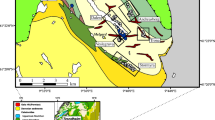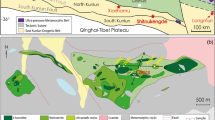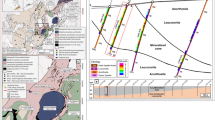Abstract
Fe–Ni-bearing serpentine from the saprolite horizon is the main Ni ores in hydrous silicate-type Ni laterites and formed by chemical weathering of partially serpentinized ultramafic rocks under tropical conditions. During lateritization, Mg, Si, and Ni are leached from the surface and transported downwards. Fe2+ is oxidized to Fe3+ and fixed as insoluble Fe-oxyhydroxides (mostly goethite) that incorporate Ni. This Ni is later leached from goethite and incorporated in secondary serpentine and garnierite. As a result, a serpentine-dominated saprolite horizon forms over the ultramafic protolith, overlapped by a Fe-oxyhydroxide-dominated limonite horizon. The serpentine from the protolith (serpentine I) is of hydrothermal origin and yields similar Ni (0.10–0.62 wt.% NiO) and lower Fe (mostly 1.37–5.81 wt.% FeO) concentrations than the primary olivine. In contrast, Fe–Ni-bearing serpentine from the saprolite (serpentine II) shows significantly higher and variable Fe and Ni contents, typically ranging from 2.23 to 15.59 wt.% Fe2O3 and from 1.30 to 7.67 wt.% NiO, suggesting that serpentine get enriched in Fe and Ni under supergene conditions. This study presents detailed mineralogical, textural, and chemical data on this serpentine II, as well as new insights by thermodynamic calculations assuming ideal solution between Fe-, Ni- and Mg-pure serpentines. The aim is to assess if at atmospheric pressure and temperature Fe–Ni-bearing serpentine can be formed by precipitation. Results indicate that the formation of serpentine II under atmospheric pressure and temperature is thermodynamically supported, and pH, Eh, and the equilibrium constant of the reaction are the parameters that affect the results more significantly.








Similar content being viewed by others
References
Aiglsperger T, Proenza JA, Lewis JF, Labrador M, Svojtka M, Rojas-Purón A, Longo F, Ďurišová J (2016) Critical metals (REE, Sc, PGE) in Ni laterites from Cuba and the Dominican Republic. Ore Geol Rev 73:127–147
Blanc P, Lassin A, Piantone P, Azaroual M, Jacquemet N, Fabbri A, Gaucher EC (2012) Thermoddem: a geochemical database focused on low temperature water/rock interactions and waste materials. Appl Geochem 27:2107–2116
Blanc P, Vieillard P, Gailhanou H, Gaboreau S, Gaucher E, Fialips CI, Madé B, Giffaut E (2015) A generalized model for predicting the thermodynamic properties of clay minerals. Am J Sci 315:734–780
Boschetti T, Toscani L (2008) Springs and streams of the Taro–Ceno valleys (northern Apennine, Italy): reaction path modeling of waters interacting with serpentinized ultramafic rocks. Chem Geol 257:76–91
Brand NW, Butt CRM, Elias M (1998) Nickel laterites: classification and features. AGSO J Australian Geol Geoph 17:81–88
Cathelineau M, Quesnel B, Gautier P, Boulvais P, Couteau C, Drouillet M (2015) Nickel dispersion and enrichment at the bottom of the regolith: formation of pimelite target-like ores in rock block joints (Koniambo Ni deposit, New Caledonia. Mineral Deposita:1–12. doi:10.1007/s00126-015-0607-y
Chen, TT, Dutrizac, JE, Krause, E, Osborne, R (2004) Mineralogical characterization of nickel laterites from New Caledonia and Indonesia. Int Laterite Nickel Symposium, pp. 79–99)
Chermak JA, Rimstidt JD (1989) Estimating the thermodynamic properties (ΔG0 f and ΔH0 f) of silicate minerals at 298 K from the sum of polyhedral contributions. Am Mineral 74:1023–1031
Dalvi, AD, Gordon Bacon, W, Osborne, RC (2004) The past and the future of nickel laterites. Prospectors and Developers Association of Canada (PDAC) International Convention, Trade Show & Investors Exchange, Toronto, Canada, 7-10 March pp 1-27
Evans BW (2004) The serpentinite multisystem revisited:chrysotile is metastable. Int Geol Rev 46:479–506. doi:10.2747/0020-6814.46.6.479
Evans BW (2008) Control of the Products of Serpentinization by the Fe2+Mg 1 Exchange Potential of Olivine and Orthopyroxene. Journal of Petrology 49:1873–1887
Evans BW, Kuehner SM, Chopelas A (2009) Magnetite-free, yellow lizardite serpentinization of olivine websterite, Canyon Mountain complex, NE Oregon. Am Mineral 94:1731–1734
Freyssinet, Ph, Butt, CRM, Morris, RC (2005) Ore-forming processes related to lateritic weathering: Econ Geol 100th Anniv Vol:681–722
Galí S, Soler JM, Proenza JA, Lewis JF, Cama J, Tauler E (2012) Ni-enrichment and stability of Al-free garnierite solid-solutions: a thermodynamic approach. Clay Clay Miner 60:121–135
Gallardo T, Tauler E, Proenza JA, Lewis JF, Galí S, Labrador M, Longo F, Bloise G (2010) Geology, mineralogy and geochemistry of the Loma Ortega Ni laterite deposit, Dominican Republic. Macla 13:89–90
Giffaut E, Grivé M, Blanc P, Vieillard P, Colàs E, Gailhanou H, Gaboreau S, Marty N, Madé B, Duro L (2014) Andra thermodynamic database for performance assessment: ThermoChimie. Appl Geochem 49:225–236
Gleeson SA, Butt CR, Elias M (2003) Nickel laterites: a review: SEG. Newsletter 54:11–18
Golightly, JP (1981) Nickeliferous laterite deposits. Econ Geol 75th Anniv Vol: 710–735.
Golightly JP (2010) Progress in understading the evolution of nickel laterites. Econ Geol Spec Pub 15:451–485
Golightly JP, Arancibia ON (1979) The chemical composition and infrared spectrum of nickel- and iron-substituted serpentine form a nickeliferous laterite profile, Soroako, Indonesia. Can Mineral 17:719–728
Haldemann E, Buchan R, Blowes J, Chandler T (1979) Geology of lateritic nickel deposits, Dominican Republic. International Laterite Symposium 4:57–84
Klein F, Bach W, Jons N, McCollom T, Moskowitz B, Berquo T (2009) Iron partitioning and hydrogen generation during serpentinization of abyssal peridotites from 15 degrees N on the mid-Atlantic ridge. Geochim Cosmochim Acta 73:6868–6893
Kuck, PH (2013) Nickel. USGS Mineral Commodity Summaries 108–109
Kuck PH (2015) Nickel. United States Geological Survey Mineral Commodity Summaries 108–109
Landauro Sotelo, EL (2008) Evaluación del riesgo ambiental por lixiviado de metales en residuos mineros y suelos empleando cuatro métodos de extracción secuencial. Master Thesis, Universitat de Girona and Universidad Politécnica de Madrid
Lewis J, Jimenez J (1991) Duarte complex in the La Vega-Jarabacoa-Janico Area, Central Hispaniola: geological and geochemical features of the sea floor during the early stages of the arc evolution. In Geologic and Tectonic development of the North America-Caribbean Plate Boundary in Hispaniola (Mann, P., Draper, G., Lewis, J.F.). Geological Society of America, Special Paper 262, 115–142.
Lewis JF, Draper G, Proenza JA, Espaillat J, Jimenez J (2006) Ophiolite-related ultramafic rocks (serpentinites) in the Caribbean region: a review of their occurrence, composition origin, emplacement and Ni-laterite soils formation. Geol Acta 4:237–263
Lithgow, E (1993) Nickel laterites of central Dominican Republic Part I. Mineralogy and ore dressing. In: Reddy, R.G., Weizenbach, R.N. (Eds.), The Paul E. Queneau Int. Symposium, Extractive Metallurgy of Copper, Nickel and cobalt, Volume I: Fundamental aspects. The Minerals, Metals and Materials Society, Portland, 403–42.
Luce, RW (1971) Identification of serpentine varieties by infra-red absorption: USGS Prof. Paper 750B, 199–201
Marchesi, C, Garrido, CJ, Godard, M, Proenza, JA, Gervilla, F, Blanco-Moreno, J (2006) Petrogenesis of highly depleted peridotites and gabbroic rocks from the Mayarí-Baracoa Ophiolitic Belt (eastern Cuba). Contrib Mineral Petrol 151:717–736.
Marchesi, C, Garrido, C, Proenza, J, Konc, Z, Hidas, K, Lewis, J (2012). Mineral and whole rock compositions of peridotites from Loma Caribe (Dominican Republic): insights into the evolution of the oceanic mantle in the Caribbean region. Geophysical Research, Abstract 14 of EGU general assembly, 2012. Vienna, Austria, 22–27
Mondesir H, Decarreau A (1987) Synthesis between 25 °C and 200 °C of Ni-Mg lizardites—experimental partition of Ni and Mg between lizardites and water. B Mineral 110:409–426
Mudd GM (2010) Global trends and environmental issues in nickel mining: sulfides versus laterites. Ore Geol Rev 38:9–26
Mudd GM, Jowitt SM (2014) A detailed assessment of global nickel resource trends and endowments. Econ Geol 109:1813–1841
Nelson CE, Proenza JA, Lewis JF, López-Kramer J (2011) The metallogenic evolution of the greater Antilles. Geol Acta 9:229–264
Normando, M.L. (2006). Caracterización Mineralógica del Perfil Saprolítico del Depósito de Lateritas Niquelíferas Yamanigüey. PhD Thesis, Universidad de Barcelona.
Nriagu JO (1975) Thermochemical approximation for clay minerals. Am Mineral 60:834–839
Orberger B, Friedrich G, Woermann (1990) The distribution of halogens and carbon in PGE-bearing ultramafics of the Acoje ophiolite block, Zambales, Philippines. J Geochem Expl 37:147–169
Parkhurst, DL, Appelo, CAJ (2012) Description of input and examples for PHREEQC version 3—a computer program for speciation, batch-reaction, one-dimensional transport, and inverse geochemical calculations. USGS Techniques and Methods, book 6, chap. A43, 497 p., available only at http://pubs.usgs.gov/tm/06 A43/
Pelletier, B (1996) Serpentines in nickel silicate ore from New Caledonia. Australasian Institute of Mining and Metallurgy Publication Series – Nickel Conference, Kalgoorlie (Western Australia) 6/96:197–205
Proenza JA, Gervilla F, Melgarejo JC (1999) Al- and Cr-rich chromitites from the Mayarí-Baracoa Ophiolitic Belt (Eastern Cuba): Consequence of interaction between volatile-rich melts and peridotites in suprasubduction mantle. Economic Geology 94:547–566
Proenza JA, Tauler E, Melgarejo JC, Galí S, Labrador M, Marrero N, Pérez-Melo N, Rojas-Purón AL, Blanco-Moreno JA (2007) Mineralogy of oxide and hydrous silicate Ni-laterite profiles in Moa Bay area, northeast Cuba. In: Andrew et al. (eds.), Digging Deeper, Irish Association for Economic Geology, Dublin, Ireland. 2: 1389–1392
Puigdomènech, I (2010) MEDUSA (Make Equilibrium Diagrams Using Sophisticated Algorithms) Windows interface to the MS-DOS versions of INPUT, SED and PREDOM (FORTRAN programs drawing chemical equilibrium diagrams) version 6 Dec 2010. Royal Institute of Technology, Stockholm, Sweden
Robie, RA, Hemingway, BS (1995) Thermodynamic properties of minerals and Related Substances at 298.15 K and 1 bar (105) Pascals) pressure and higher temperatures: U.S. Geological Survey Bulletin, v. 2131, 461 p.
Roqué-Rosell, J, Mosselmans, JFW, Proenza, JA, Labrador, M, Galí, S, Atkinson, KD, Quinn, PD (2010) Sorption of Ni by "lithiophorite-asbolane" intermediates in Moa Bay lateritic deposits, eastern Cuba. Chem Geol 275:9–18.
Roqué-Rosell, J, Villanova-de-Benavent, C, Proenza, JA (2016) The accumulation of Ni in garnierites and serpentines from Falcondo Ni-laterite deposit (Dominican Republic) elucidated by means of μXAS. Geochim Cosmochim Acta (in press)
Sleep NH, Meibom A, Fridriksson T, Coleman RG, Bird DK (2004) H2-rich fluids from serpentinization: geochemical and biotic implications. PNAS 101(35):12818–12823
Streit E, Kelemen P, Eiler J (2012) Coexisting serpentine and quartz from carbonate-bearing serpentinized peridotite in the Smail ophiolite, Oman. Contrib Mineral Petr 164:821–837
Tauler E, Buen H, Proenza JA, Galí S, Melgarejo JC, Labrador M, Marrero N (2007) Tres generaciones de serpentina en el perfil laterítico del NE de Cuba. Macla 7:110
Tauler E, Proenza J, Galí S, Lewis J, Labrador M, García-Romero E (2009) Ni-sepiolite-falcondoite in garnierite mineralisation from the Falcondo Ni-laterite deposit, Dominican Republic. Clay Miner 44:435–454
Trescases, JJ (1973) L’évolution géochimique supergène des roches ultrabasiques en zone tropicale et la formation des gisements nickélifères de Nouvelle-Calédonie. PhD thesis, Université Louis Pasteur, Strasbourg.
Trescases JJ (1979) Remplacement progressif des silicates par les hydroxides de fer et de nickel dans les profils d’altération tropicale des roches ultrabasiques. Accumulation résiduelle et épigenie. Sci Géol Bull 32:181–188
Vieillard P (1994a) Prediction of enthalpy of formation based on refined crystal structures of multisite compounds: part 1. Theories and examples. Geochim Cosmochim Acta 58:4049–4063. doi:10.1016/0016-7037(94)90266-6
Vieillard P (1994b) Prediction of enthalpy of formation based on refined crystal structures of multisite compounds: part 2. Application to minerals belonging to the system Li2O-Na2O-K2O-BeO-MgO-CaO-MnO-FeO-Fe2O3-Al2O3-SiO2-H2O. Results and discussion. Geochim Cosmochim Acta 58:4065–4107. doi:10.1016/0016-7037(94)90267-4
Vieillard P (2000) A new method for the prediction of Gibbs free energies of formation of hydrated clay minerals based on the electronegativity scale. Clay Clay Miner 48:459–473
Vieillard P (2002) A new method for the prediction of Gibbs free energies of formation of phyllosilicates (10 A and 14 A) based on the electronegativity scale. Clay Clay Miner 50:352–363
Villanova-de-Benavent C, Proenza JA, Galí S, García-Casco A, Tauler E, Lewis JF, Longo F (2014) Garnierites and garnierites: textures, mineralogy and geochemistry of garnierites in the Falcondo Ni-laterite deposit, Dominican Republic. Ore Geol Rev 58:91–109
Wells MA, Ramanaidou ER, Verrall M, Tessarolo C (2009) Mineralogy and crystal chemistry of garnierites in the Goro lateritic nickel deposit, New Caledonia. Eur J Mineral 21:467–483
Whitney DL, Evans BW (2010) Abbreviations for names of rock-forming minerals. Am Mineral 95:185–187
Wicks FJ, Plant AG (1979) Electron microprobe and X-ray microbeam studies of serpentine textures. Can Mineral 17:785–830
Wilson J, Savage D, Cuadros J, Shibata M, Ragnasdottir KV (2006) The effect of iron on montmorillonite stability. (I) background and thermodynamic considerations. Geochim Cosmochim Acta 70:306–322
Acknowledgments
This research has been financially supported by FEDER Funds, the Spanish projects CGL2009-10924 and CGL2012-36263, and Catalan project 2014-SGR-1661 and a PhD grant to Cristina Villanova-de-Benavent sponsored by the Ministerio de Educación (Spain). The help and hospitality extended by the staff at Falcondo Xstrata mine are also gratefully acknowledged. The authors also thank Dr. Thomas Aiglsperger for the comments on the paper prior to submission and Prof. J.P. Golightly, Editor-in-Chief Georges Beaudoin, Associate Editor Beate Orberger and two anonymous reviewers for their accurate revisions and constructive suggestions that highly improved the quality of the manuscript.
Author information
Authors and Affiliations
Corresponding author
Ethics declarations
Conflict of interest
The authors declare that they have not conflict of interest.
Additional information
Editorial handling: B. Orberger
Rights and permissions
About this article
Cite this article
Villanova-de-Benavent, C., Domènech, C., Tauler, E. et al. Fe–Ni-bearing serpentines from the saprolite horizon of Caribbean Ni-laterite deposits: new insights from thermodynamic calculations. Miner Deposita 52, 979–992 (2017). https://doi.org/10.1007/s00126-016-0683-7
Received:
Accepted:
Published:
Issue Date:
DOI: https://doi.org/10.1007/s00126-016-0683-7




